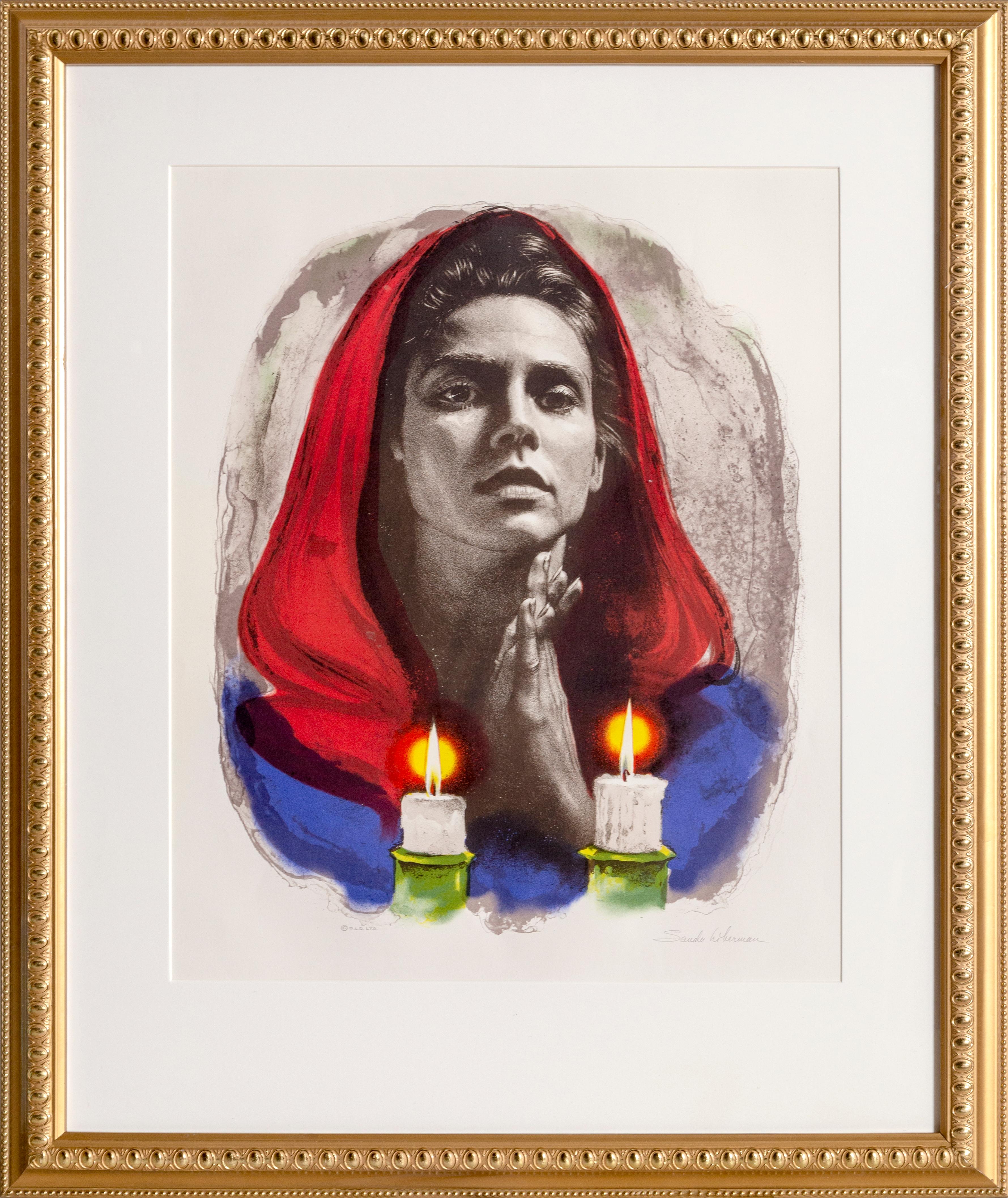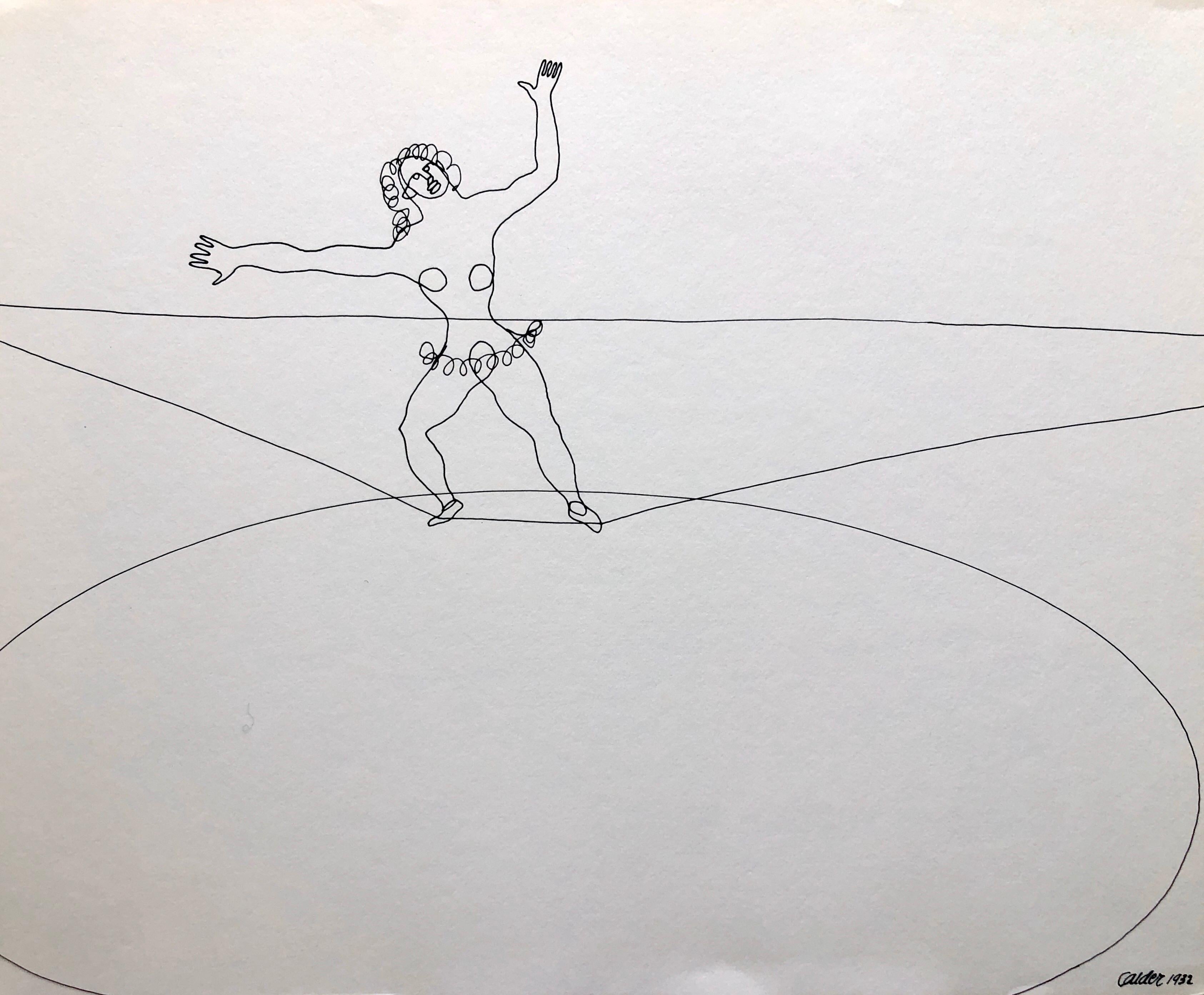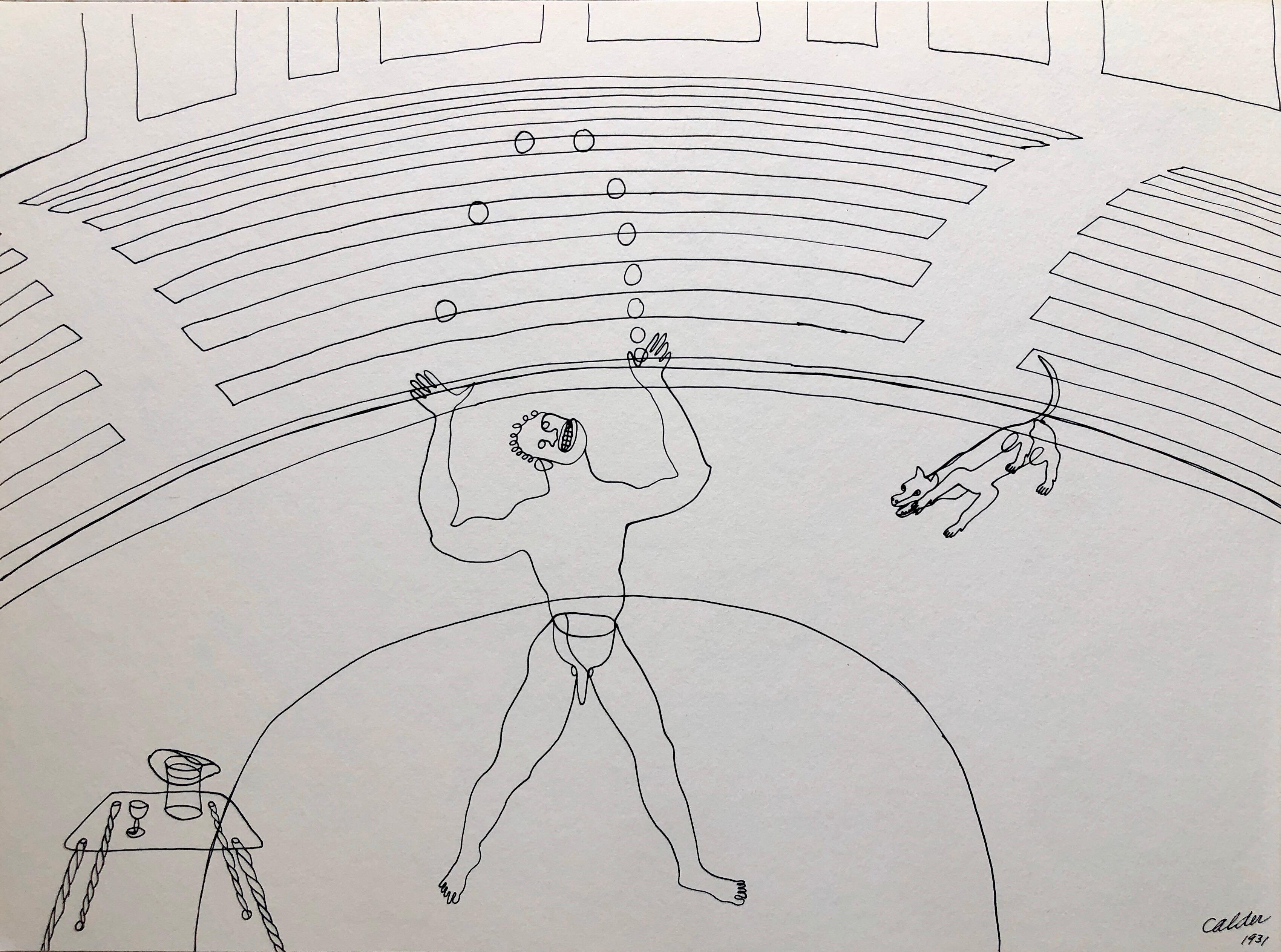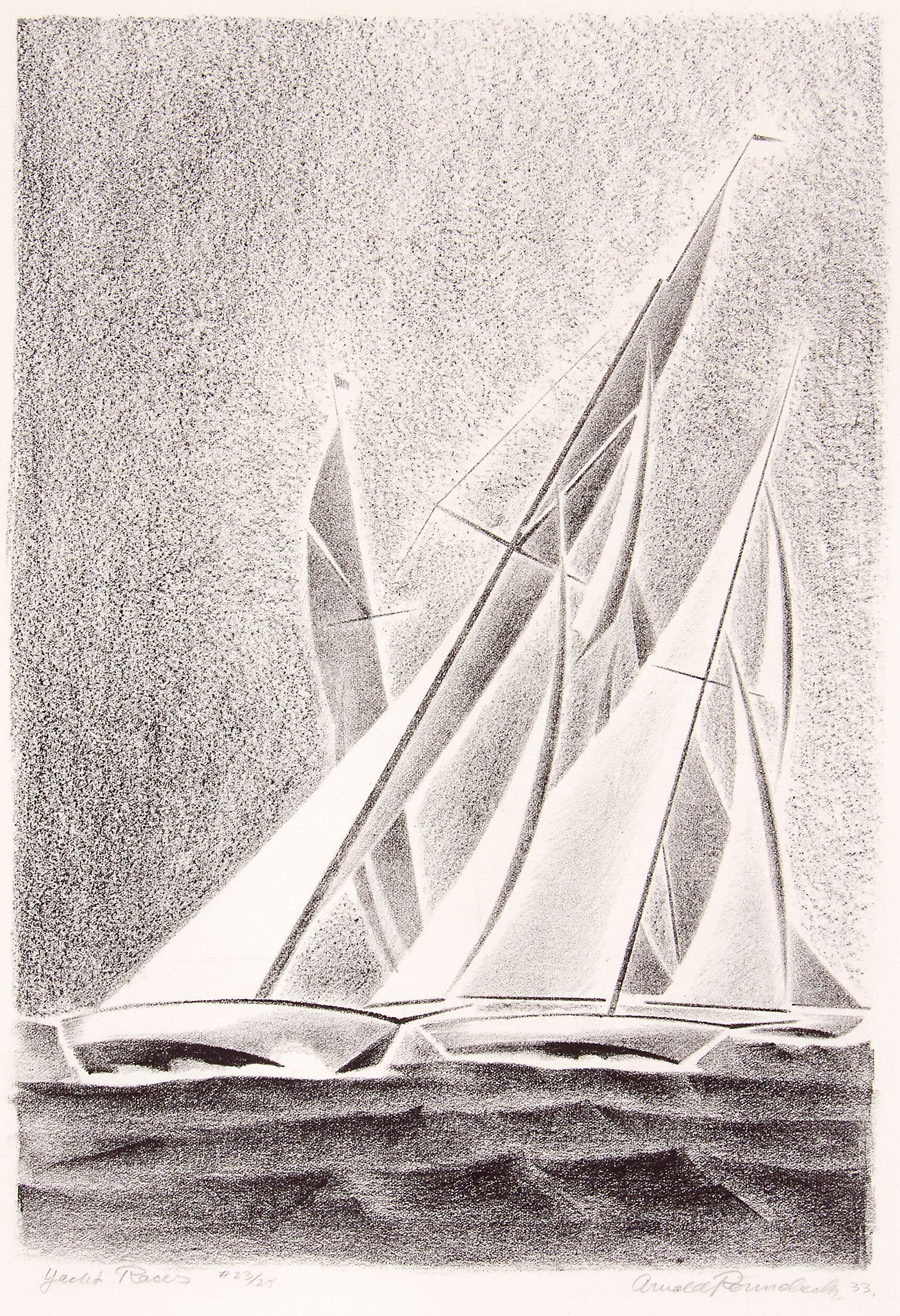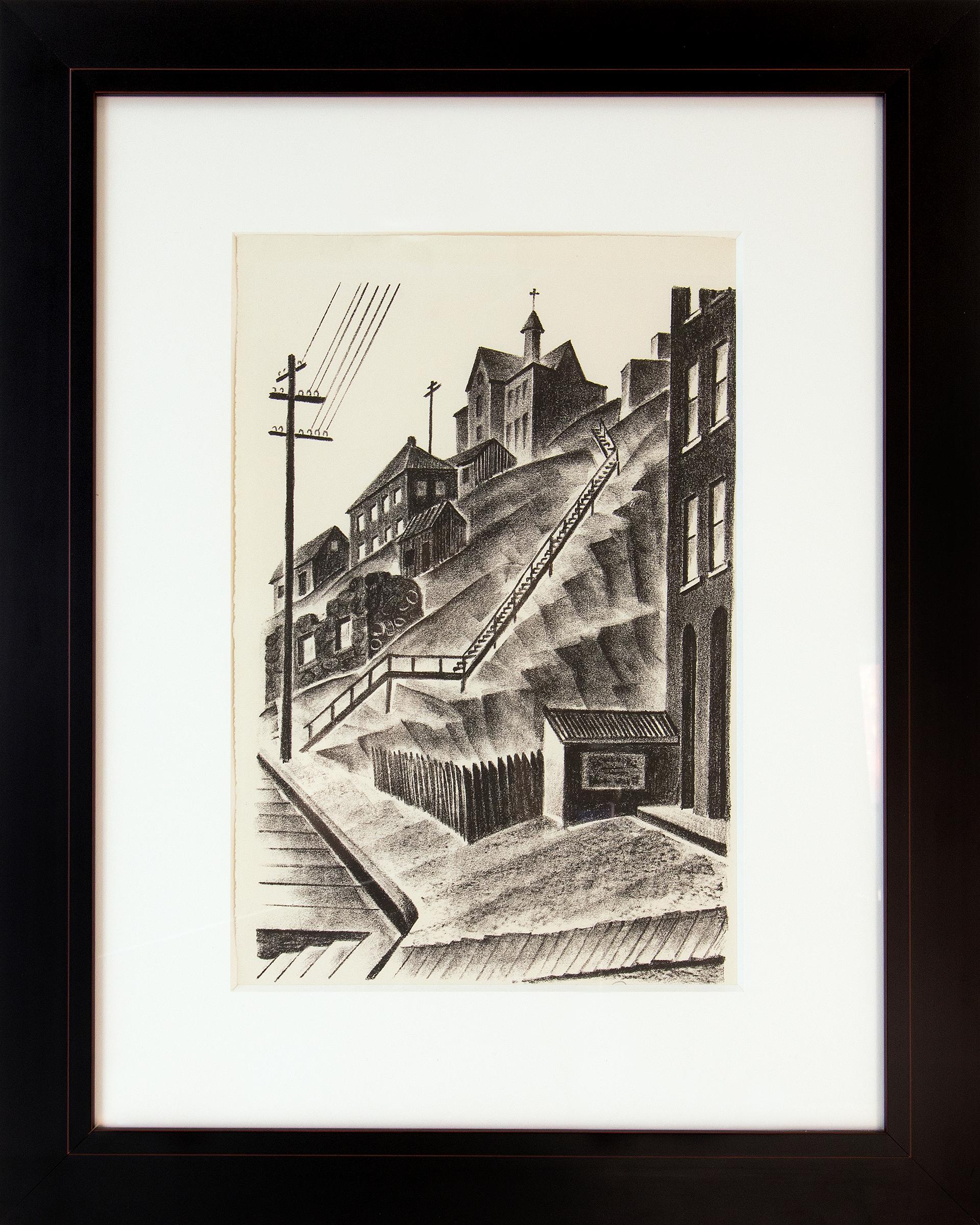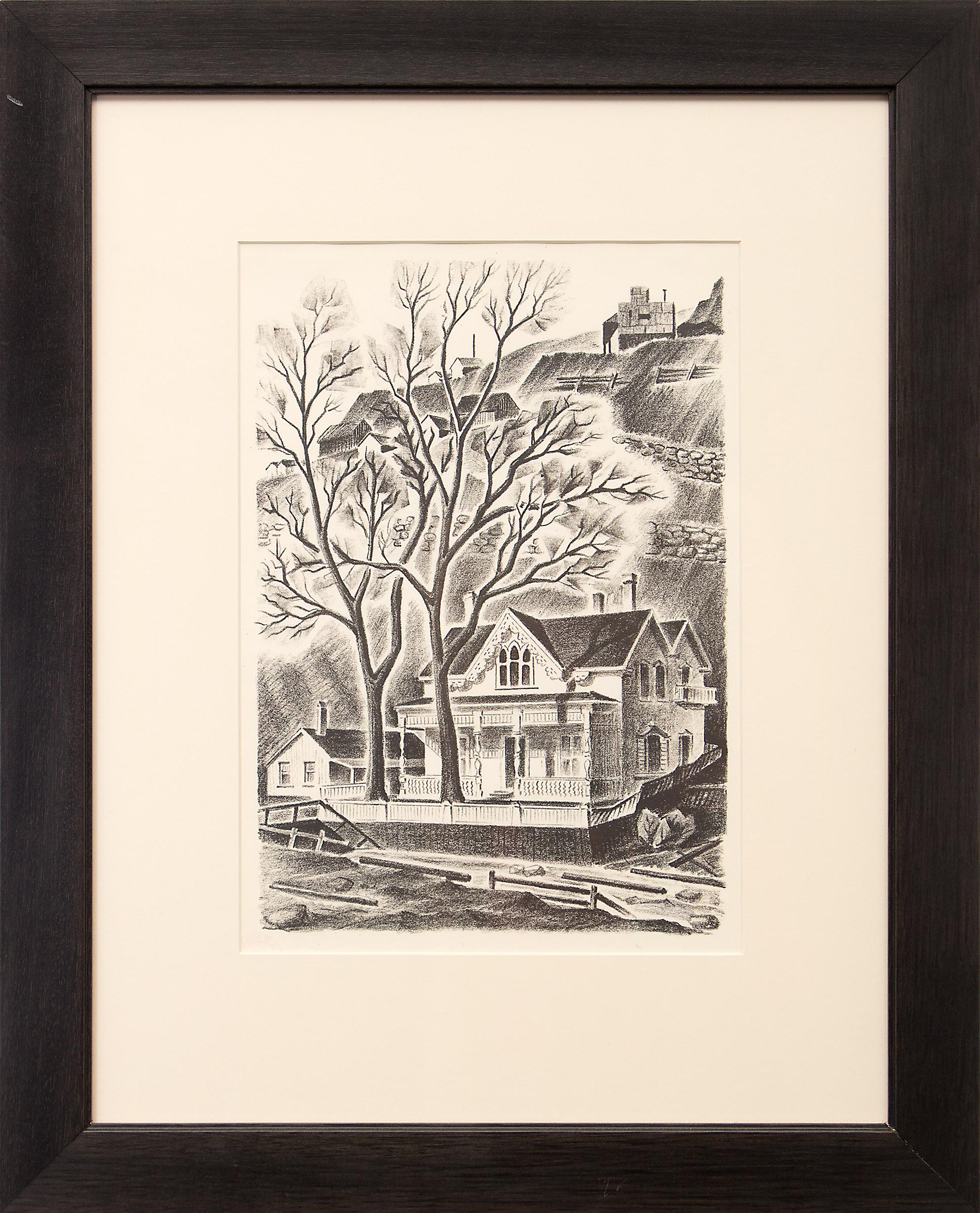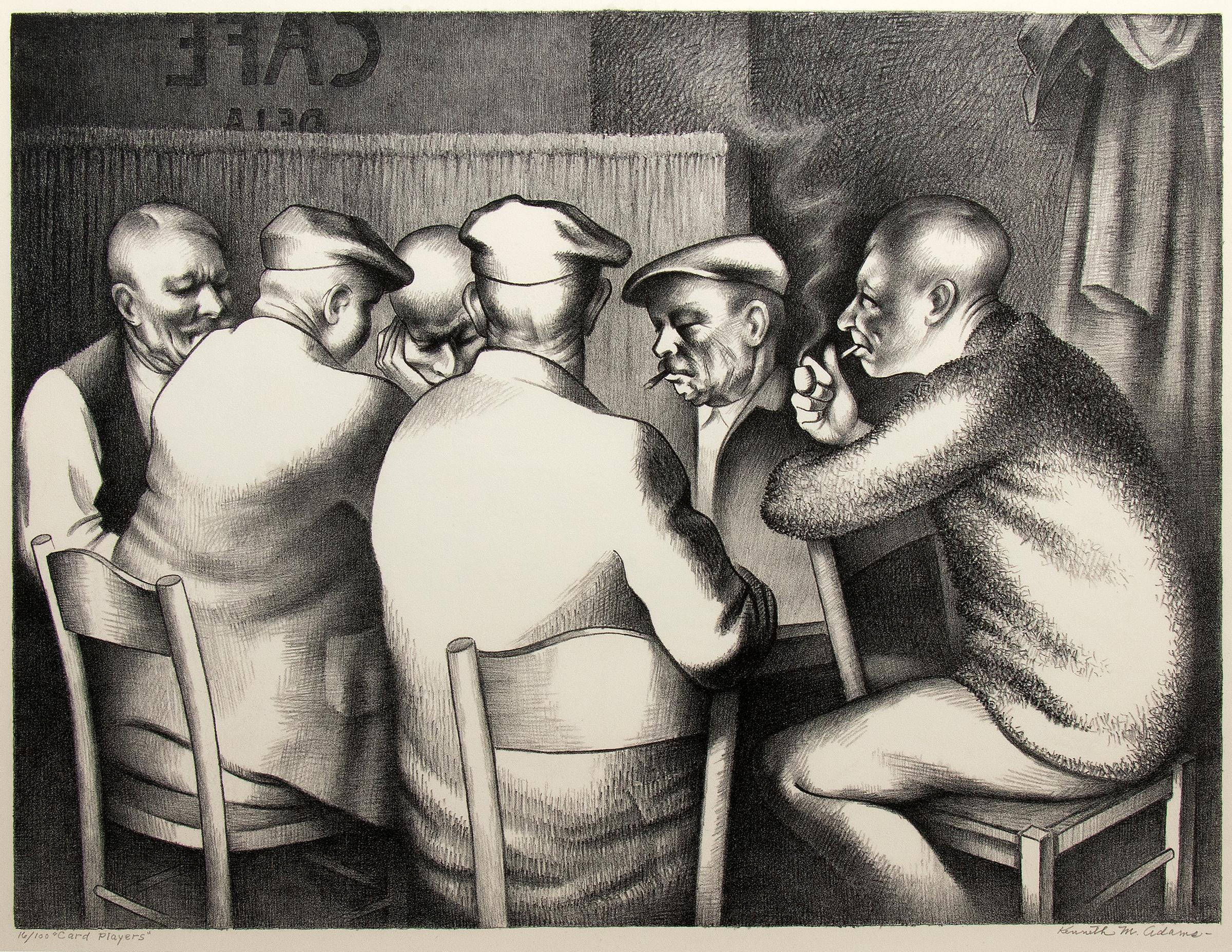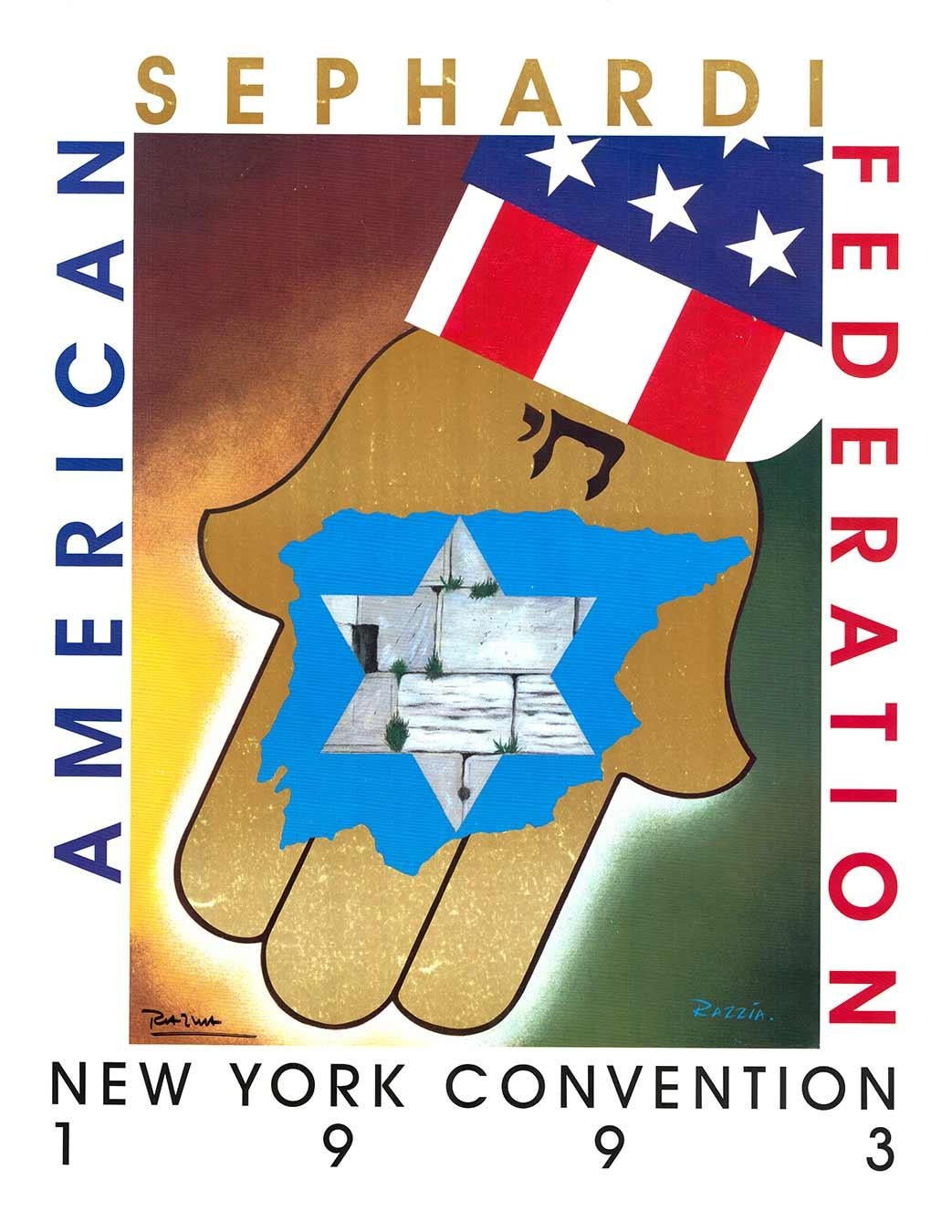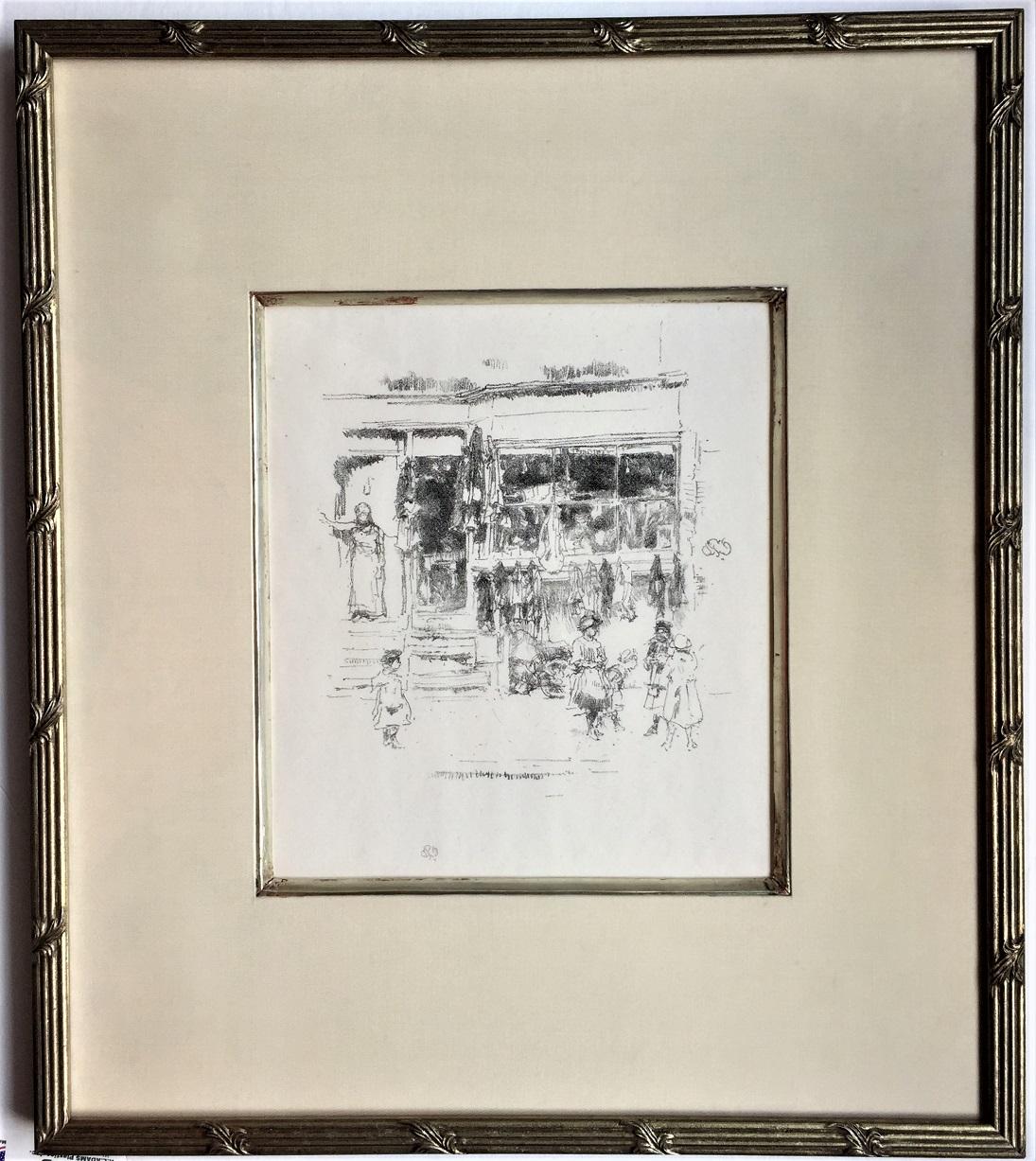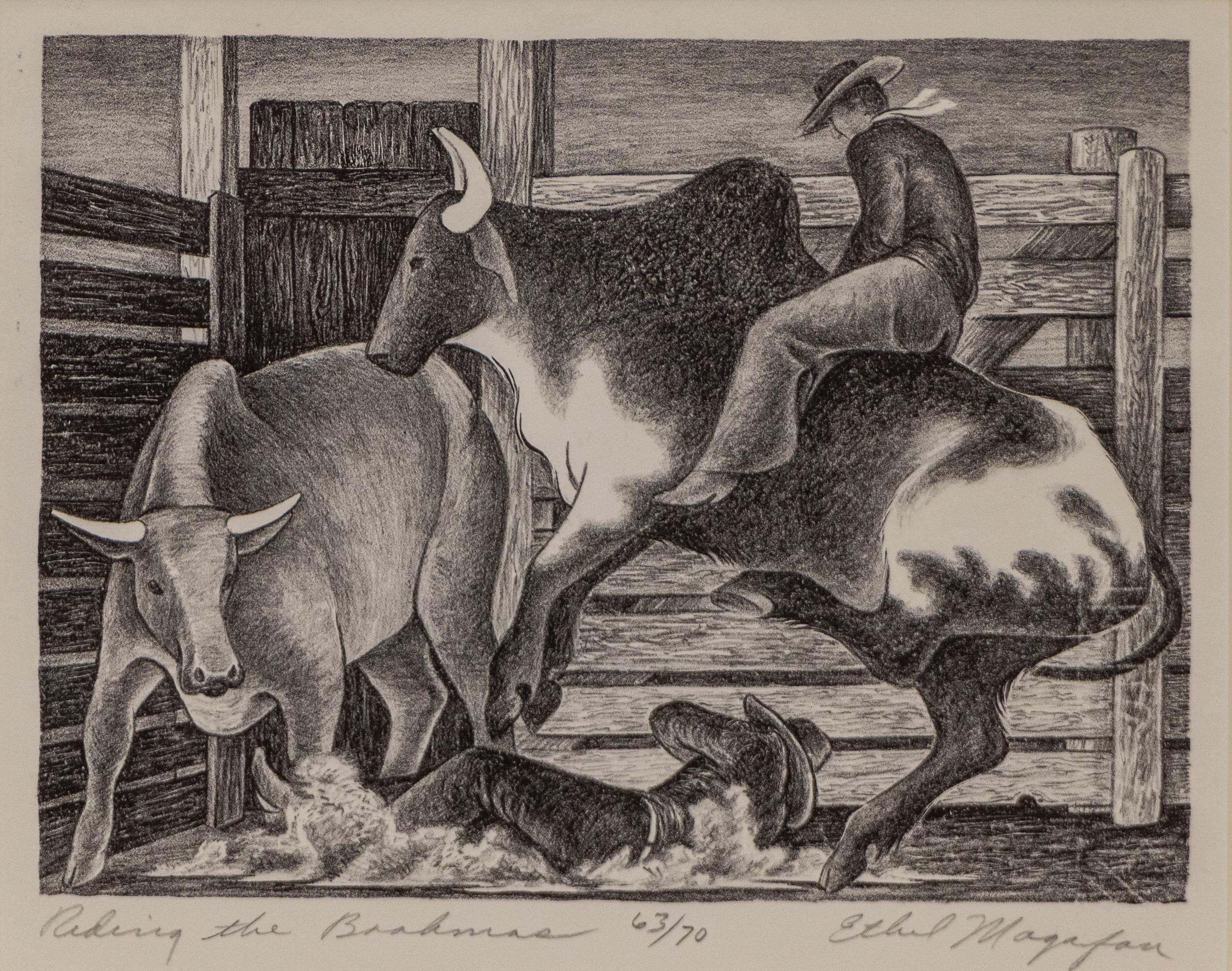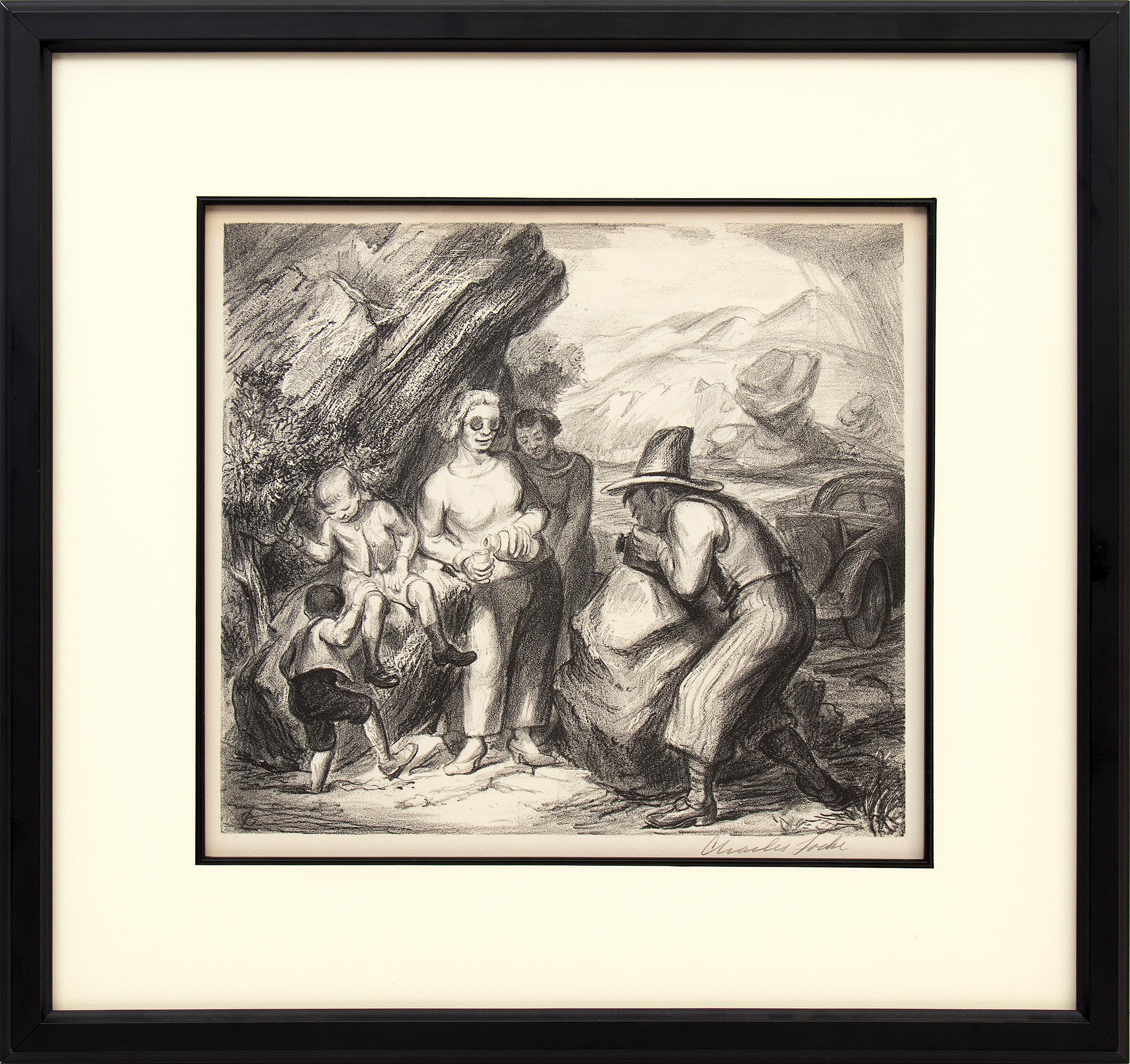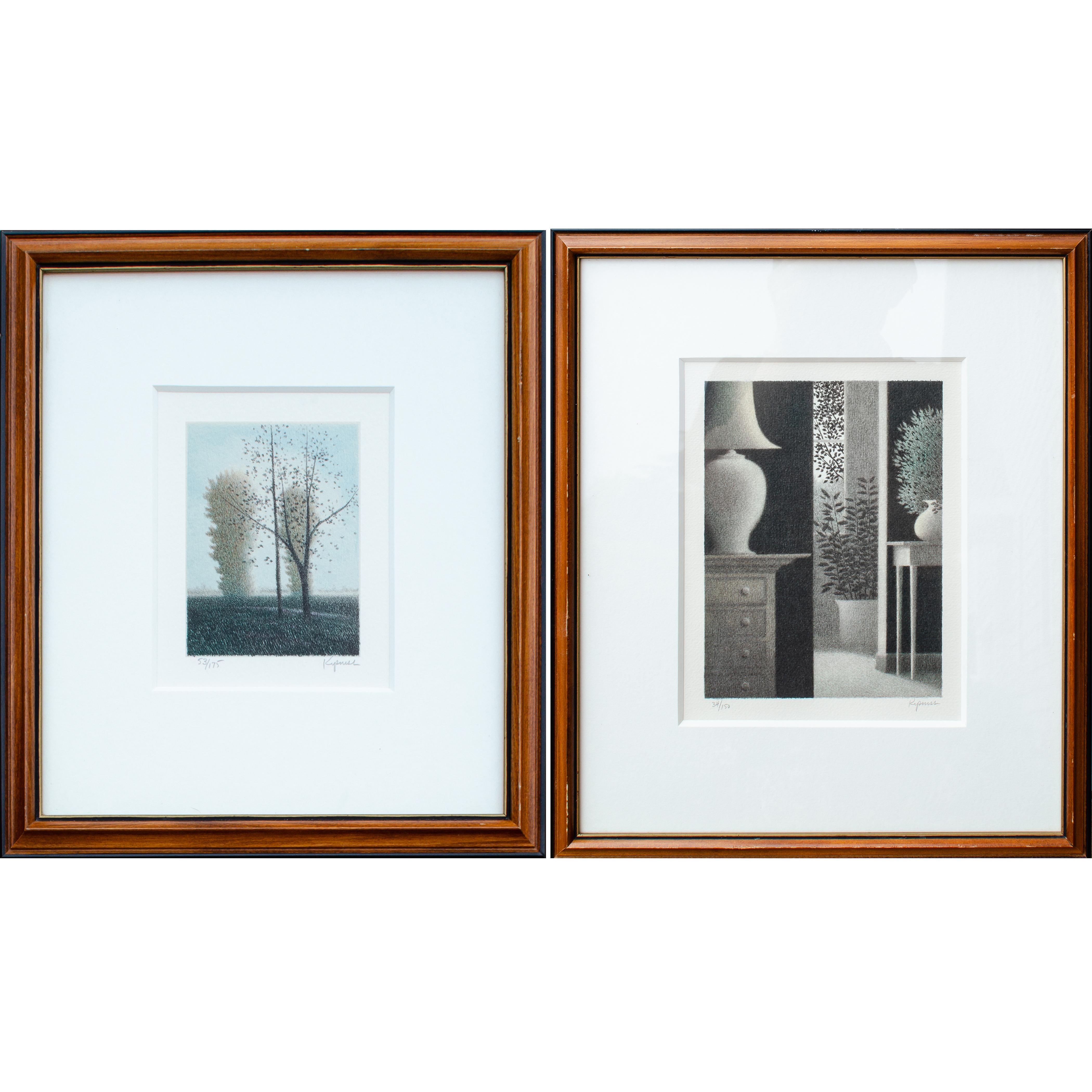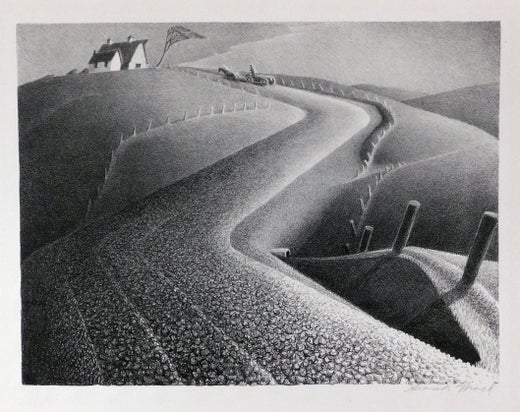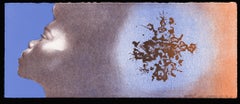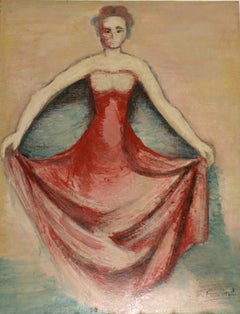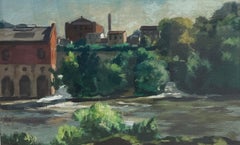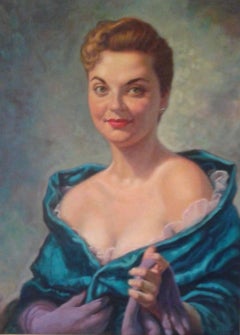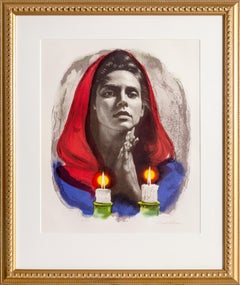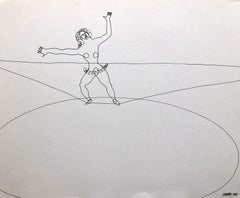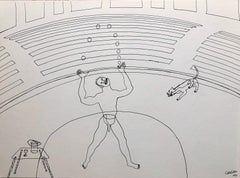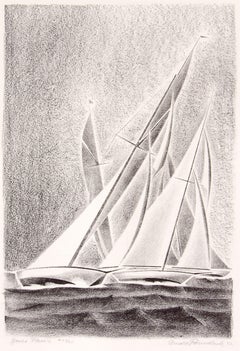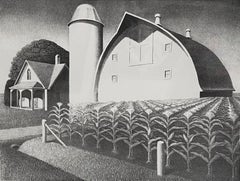
Fertility
View Similar Items
Want more images or videos?
Request additional images or videos from the seller
1 of 10
Grant WoodFertility1939
1939
$8,500List Price
About the Item
- Creator:Grant Wood (1891 - 1942, American)
- Creation Year:1939
- Dimensions:Height: 12.625 in (32.07 cm)Width: 19.125 in (48.58 cm)
- Medium:
- Movement & Style:
- Period:
- Condition:
- Gallery Location:Rancho Santa Fe, CA
- Reference Number:1stDibs: LU516312050682
Grant Wood
One of the major American Regionalist painters along with Thomas Hart Benton and John Steuart Curry, Grant Wood was born in Anamosa, Iowa, and spent his childhood in Cedar Rapids. Unlike Curry and Benton, he never moved East but remained in the Middle West where he found inspiration for his paintings of prosperous farms and people reflecting idealized American values. However, his work was set apart from many regionalists in that provoked both laughter and social indignation. A good example Daughters of Revolution, 1932, depicting the aloof smugness of women who regarded themselves as emblematic of the country's founding values This painting was a retaliation by Wood against DAR members who had criticized him for completing their window in Germany instead of America. Much of his satire was good natured and humorous. For two summers, Wood attended the Minneapolis School of Design and Handicraft and Normal Art as a student of Ernest Batchelder, and he had brief times of study at Iowa State University and the Art Institute of Chicago from 1913 to 1916. After World War I, he taught high school art in Cedar Rapids. Asserting that he "had to go to France to appreciate Iowa," he had several trips abroad, and in 1923 enrolled in the Academie Julian in Paris, but he determined to make his life in Iowa because "all the really good ideas I'd ever had came to me while I was milking a cow." In 1932, he was co-founder of the Stone City Art Colony and Art School and he became director of the Public Works Art Project in Iowa. He was also an Associate Professor of Fine Arts at the University of Iowa. His work can be divided into two periods, the first being views of Cedar Rapids, other landscapes including scenes of Europe, and a few portraits. However, in 1928, his work changed when he traveled to Munich to oversee the making of a stained-glass window for the Cedar Rapids Veterans Memorial Building commissioned by the Daughters of the American Revolution. Seeing the severe, austere new style of painting in Germany combined with work from the late Gothic period, he developed a unique new style of his own that treated mid-western subjects with Gothic overtones, satire, and caricature. In 1930, he produced his first major landscape painting, Stone City, that had exaggerated perspective and unique naive treatment. From that time, his paintings had a simple innocence and fantasy that transported the viewer into another world, often that of a child. He also did many murals and a few lithographs, completing nineteen between 1937 and 1942, the year he died of cancer at age 50 in Iowa City. Sources include:
Matthew Baigell, Dictionary of American Art
Michael David Zellman, 300 Years of American Art
About the Seller
5.0
Vetted Professional Seller
Every seller passes strict standards for authenticity and reliability
Established in 1984
1stDibs seller since 2016
89 sales on 1stDibs
Typical response time: 17 hours
Authenticity Guarantee
In the unlikely event there’s an issue with an item’s authenticity, contact us within 1 year for a full refund. DetailsMoney-Back Guarantee
If your item is not as described, is damaged in transit, or does not arrive, contact us within 7 days for a full refund. Details24-Hour Cancellation
You have a 24-hour grace period in which to reconsider your purchase, with no questions asked.Vetted Professional Sellers
Our world-class sellers must adhere to strict standards for service and quality, maintaining the integrity of our listings.Price-Match Guarantee
If you find that a seller listed the same item for a lower price elsewhere, we’ll match it.Trusted Global Delivery
Our best-in-class carrier network provides specialized shipping options worldwide, including custom delivery.More From This Seller
View AllCharles White "Blues" 1971 African American Artist - Color Lithograph Framed
Located in Rancho Santa Fe, CA
A wonderful print by African American artist, Charles White (1918 - 1979)
"Blues"
Color lithograph on Rives paper, 1971.
11.5 x 26.75 inches (28.55 x 68.7 cm)
Signed, titled, dated and numbered in pencil, lower right.
Number 63/100 from the numbered edition of 100.
Framed
Printed by William Law III and the Tamstone Group, Los Angeles, with their blindstamps lower right.
Charles Wilbert White...
Category
1970s American Modern Figurative Prints
Materials
Archival Paper, Lithograph
Modern Dance Female Dancer in Red Dress Jazz - oil paint on board circa 1950s
By Raimondo Puccinelli
Located in Rancho Santa Fe, CA
Signed lower right
Raimondo (Raymond) Puccinelli (American, 1904-1986).
Puccinelli began art training at age 15 at the California School of Fine Art (now the San Francisco Art Institute) and the Schaeffer School of Design. While in Italy in 1927, he studied ancient Italian sculpture (Romanesque, Gothic, and late Renaissance) which affected his future work. After a year of studying in France and Italy with various craftsmen, he returned to San Francisco to assist in the studio of J. Vieira and study under Benny Bufano...
Category
Mid-20th Century American Modern Figurative Paintings
Materials
Oil, Board
Manayunk Schuylkill River Factory City Scene Philadelphia GIOVANNI MARTINO 1970
By Giovanni Martino
Located in Rancho Santa Fe, CA
Provenance: Private Collection, San Diego, CA.
Framed
Giovanni Martino, National Academy of Design* member, was born on May 1, 1908 in Philadelphia PA where all seven brothers and one sister, Filomina, Frank, Antonio, Albert, Ernest, Giovanni, Edmond, and William became painters. They were under the tutelage of their eldest brother, Frank, who in the late 1920s, founded the first commercial art* studio, Martino Studios, at 27 South 18th Street.
Besides studying with his two eldest brothers, Giovanni also studied with Albert Jean Adolph at La France Institute, The Pennsylvania Academy of the Fine Arts*, The Graphic Sketch Club, and Spring Garden Institute in Philadelphia. In his mid teens he accompanied his two eldest brothers to New Hope searching for subjects to paint. In the 1930s, he also started to paint in Manayunk, a hilly mill town along the Schuylkill River. At this time he signed his paintings M. Giovanni.
These colorful impressionistic* works proceeded more thinly painted dramatically poetic street scenes of the mill town. These images developed into impasto* laden oils in the 1960's with some of the paintings worked with a palette knife*.
In Manayunk, he was a common sight on the streets and sidewalks, painting on-the-spot with his wife, Eva Marinelli and his two daughters, Nina & Babette. In the 1980's and 90's he also painted in Conshohocken and Norristown with his youngest daughter, Babette. His paintings became more sharply executed like his earlier work but were more colorful. In the late '90's he worked in his studio to enlarge paintings.
He is the recipient of over 100 awards and honors. He received the Benjamin Altman Prize in Landscape Painting in 1975 at the National Academy of Design, NYC where he was elected an Academician (NA) in 1944. He mentored not only his wife and two daughters but also taught at Lehigh University and the Graphic Sketch Club, Philadelphia.
He died at his home in Blue Bell on February 1, 1997. (Babette Martino...
Category
1970s American Modern Landscape Paintings
Materials
Paper, Mixed Media, Oil, Tempera
SALVADOR DE REGIL 1954 Portrait of Marian Virginia Schuster - Surrealist Artist
By Salvador De Regil
Located in Rancho Santa Fe, CA
Marian Schuster was 19 years old in 1954 and attended City College San Francisco where she studied Art.
In the old school, Victorian, San Francisco, moneyed household that she was r...
Category
1950s American Modern Portrait Paintings
Materials
Canvas, Oil
Abstract painting of People on the Beach oil on canvas circa 1950-1960 New York
By Aaron Berkman
Located in Rancho Santa Fe, CA
Aaron Berkman (New York, 1900 - 1929)
"Beach"
Oil on canvas
20 x 24 inches
Signed lower right: Aaron Berkman
Unframed
Provenance: Private collection, USA
An abstract oil painting o...
Category
Mid-20th Century American Modern Figurative Paintings
Materials
Canvas, Oil
The Party - oil on canvas - New York City town house at night - 20th century
By Aaron Berkman
Located in Rancho Santa Fe, CA
Oil on canvas
30 x 24 inches
Signed verso
Not framed
Provenance:
Private collection, USA
Aaron Berkman was born in Hartford, Connecticut where his parents had been settled since 1...
Category
Mid-20th Century American Modern Figurative Paintings
Materials
Canvas, Oil
You May Also Like
Shabbas Candles, Lithograph by Sandu Liberman
By Sandu Liberman
Located in Long Island City, NY
Shabbas Candles by Sandu Liberman, Romanian/Israeli (1923–1977)
Date: circa 1970
Edition: 64/175
Lithograph, signed in pencil
Image Size: 20 x 13 inches
Size: 30 x 21.5 in. (76.2 x 5...
Category
1970s American Modern Figurative Prints
Materials
Lithograph
$760 Sale Price
20% Off
Alexander Calder Circus Reproduction Lithograph of a Drawing
By (after) Alexander Calder
Located in Surfside, FL
(after) Alexander Calder
"Calder's Circus" offset lithograph on wove paper a reproduction lithograph after the drawings by the artist
Published by Art in America and Perls gallery in 1964 (from drawings done in the 1930's)
these range slightly in size but they are all about 13 X 17 inches (with minor variations in size as issued.) These have never been framed. The outer folio is not included just the one lithograph.
James Sweeny from the introduction “The fame of Calder’s circus spread quickly between the years 1927 and 1930. All the Paris art world came to know it. It brought him his first great personal success. But what was more important, the circus also provided the first steps in Calder’s development as an original sculptor”
Clive Gray wrote ”A visit to the studio of Alexander Calder led to the chance discovery of some hundred masterful circus drawings completed over thirty years ago. We publish, for the first time, a choice of sixteen from that group.” With signed introduction by Miro.
These whimsical drawings, done in the style of wire sculpture, include acrobats, clowns, jugglers, trapeeze artists, an elephant, dog and lion. they are great.
Alexander Calder is widely considered to be one of the most important American sculptors of the 20th century. He is best known for his colorful, whimsical abstract public sculptures and his innovative mobiles, kinetic sculptures powered by motors or air currents, which embraced chance in their aesthetic. Born into a family of accomplished artists, Calder's work first gained attention in Paris in the 1930s and was soon championed by the Museum of Modern Art in New York, resulting in a retrospective exhibition in 1943. Major retrospectives were also held at the Solomon R. Guggenheim Museum (1964) and the Museum of Contemporary Art, Chicago (1974). Calder’s work is in many permanent collections, most notably in the Whitney Museum of American Art, but also the Guggenheim Museum; the Museum of Modern Art; the National Gallery of Art, Washington, D.C.; and the Centre Georges Pompidou. He produced many large public works, including .125 (at JFK Airport, 1957), Pittsburgh (Carnegie International prize winner 1958, Pittsburgh International Airport) Spirale (UNESCO in Paris, 1958), Flamingo and Universe (both in Chicago, 1974), and Mountains and Clouds (Hart Senate Office Building, Washington, D.C., 1976). Although primarily known for his sculpture, Calder was a prodigious artist with a restless creative spirit, whose diverse practice included painting and printmaking, miniatures (such as his famous Cirque Calder), children’s book illustrations, theater set design, jewelry design, tapestry and rug works, and political posters. Calder was honored by the US Postal Service with a set of five 32-cent stamps in 1998, and received the Presidential Medal of Freedom, posthumously in 1977, after refusing to receive it from Gerald Ford one year earlier in protest of the Vietnam War.
Calder moved to New York and enrolled at the Art Students League, studying briefly with Thomas Hart Benton, George Luks, Kenneth Hayes Miller, and John Sloan. While a student, he worked for the National Police Gazette where, in 1925, one of his assignments was sketching the Ringling Bros. and Barnum & Bailey Circus. Calder became fascinated with the action of the circus, a theme that would reappear in his later work.
In 1926, Calder moved to Paris, enrolled in the Académie de la Grande Chaumière, and established a studio at 22 rue Daguerre in the Montparnasse Quarter. In June 1929, while traveling by boat from Paris to New York, Calder met his future wife, Louisa James (1905-1996), grandniece of author Henry James and philosopher William James. They married in 1931. While in Paris, Calder met and became friends with a number of avant-garde artists, including Fernand Léger, Jean Arp, and Marcel Duchamp. Cirque Calder (on view at the Whitney Museum of American Art at present) became popular with the Parisian avant-garde. He also invented wire sculpture, or "drawing in space," and in 1929 he had his first solo show of these sculptures in Paris at Galerie Billiet. Hi! (Two Acrobats) in the collection of the Honolulu Museum of Art is an early example of the artist's wire sculpture. The painter Jules Pascin, a friend of Calder's from the cafes of Montparnasse, wrote the preface to the catalog. A visit to Piet Mondrian's studio in 1930, where he was impressed by the environment-as-installation, "shocked" him into fully embracing abstract art, toward which he had already been tending.
Dating from 1931, Calder’s sculptures of discrete movable parts powered by motors were christened “mobiles” by Marcel Duchamp, a French pun meaning both "motion" and "motive." At the same time, Calder was also experimenting with self-supporting, static, abstract sculptures, dubbed "stabiles" by Jean Arp in 1932 to differentiate them from mobiles.
Public commissions increasingly came his way in the 1960s. Notable examples are .125 for JFK Airport in 1957, Spirale for UNESCO in Paris 1958 and Trois disques, commissioned for Expo 67 in Montreal, Quebec, Canada. Calder's largest sculpture at 25.7 meters high was El Sol Rojo, constructed outside the Aztec Stadium for the 1968 Summer Olympics "Cultural Olympiad" events in Mexico City. Many of his public works were commissioned by renowned architects; I.M. Pei commissioned his La Grande Voile (1966), a 25-ton, 40-foot high stabile for the Massachusetts Institute of Technology.
Part of Calder's repertoire includes pivotal stage sets for more than a dozen theatrical productions, including Nucléa, Horizon, and most notably, Martha Graham’s Panorama (1935), a production of the Erik Satie symphonic drama Socrate (1936), and later, Works in Progress (1968).
In addition to sculptures, Calder painted throughout his career, beginning in the early 1920s. He picked up his study of printmaking in 1925, and continued to produce illustrations for books and journals.As Calder’s professional reputation expanded in the late 1940s and 1950s, so did his production of prints. Masses of lithographs based on his gouache paintings hit the market, and deluxe editions of plays, poems, and short stories illustrated with fine art prints by Calder became available for sale.
One of Calder's most celebrated and unconventional undertakings was a commission from Dallas-based Braniff International Airways to paint a full-size Douglas DC-8-62 four-engined jet as a "flying canvas."
Calder created over 2,000 pieces of jewelry over the course of his career, many of them as gifts for friends and relatives. For his lifelong friend Joan Miró, he set a shard of a broken porcelain vessel in a brass ring. Peggy Guggenheim received enormous silver mobile earrings and later commissioned a hammered silver headboard...
Category
1930s American Modern Animal Prints
Materials
Lithograph
Alexander Calder Circus Reproduction Lithograph After a Drawing
By (after) Alexander Calder
Located in Surfside, FL
(after) Alexander Calder
"Calder's Circus" offset lithograph on wove paper after drawings by the artist
Published by Art in America and Perls gallery in 1964 (from drawings done in the 1930's)
these range slightly in size but they are all about 13 X 17 inches (with minor variations in size as issued.) These have never been framed. The outer folio is not included just the one lithograph.
James Sweeny from the introduction “The fame of Calder’s circus spread quickly between the years 1927 and 1930. All the Paris art world came to know it. It brought him his first great personal success. But what was more important, the circus also provided the first steps in Calder’s development as an original sculptor”
Clive Gray wrote ”A visit to the studio of Alexander Calder led to the chance discovery of some hundred masterful circus drawings completed over thirty years ago. We publish, for the first time, a choice of sixteen from that group.” With signed introduction by Miro.
These whimsical drawings, done in the style of wire sculpture, include acrobats, clowns, jugglers, trapeeze artists, an elephant, dog and lion. they are great.
Alexander Calder is widely considered to be one of the most important American sculptors of the 20th century. He is best known for his colorful, whimsical abstract public sculptures and his innovative mobiles, kinetic sculptures powered by motors or air currents, which embraced chance in their aesthetic. Born into a family of accomplished artists, Calder's work first gained attention in Paris in the 1930s and was soon championed by the Museum of Modern Art in New York, resulting in a retrospective exhibition in 1943. Major retrospectives were also held at the Solomon R. Guggenheim Museum (1964) and the Museum of Contemporary Art, Chicago (1974). Calder’s work is in many permanent collections, most notably in the Whitney Museum of American Art, but also the Guggenheim Museum; the Museum of Modern Art; the National Gallery of Art, Washington, D.C.; and the Centre Georges Pompidou. He produced many large public works, including .125 (at JFK Airport, 1957), Pittsburgh (Carnegie International prize winner 1958, Pittsburgh International Airport) Spirale (UNESCO in Paris, 1958), Flamingo and Universe (both in Chicago, 1974), and Mountains and Clouds (Hart Senate Office Building, Washington, D.C., 1976). Although primarily known for his sculpture, Calder was a prodigious artist with a restless creative spirit, whose diverse practice included painting and printmaking, miniatures (such as his famous Cirque Calder), children’s book illustrations, theater set design, jewelry design, tapestry and rug works, and political posters. Calder was honored by the US Postal Service with a set of five 32-cent stamps in 1998, and received the Presidential Medal of Freedom, posthumously in 1977, after refusing to receive it from Gerald Ford one year earlier in protest of the Vietnam War.
Calder moved to New York and enrolled at the Art Students League, studying briefly with Thomas Hart Benton, George Luks, Kenneth Hayes Miller, and John Sloan. While a student, he worked for the National Police Gazette where, in 1925, one of his assignments was sketching the Ringling Bros. and Barnum & Bailey Circus. Calder became fascinated with the action of the circus, a theme that would reappear in his later work.
In 1926, Calder moved to Paris, enrolled in the Académie de la Grande Chaumière, and established a studio at 22 rue Daguerre in the Montparnasse Quarter. In June 1929, while traveling by boat from Paris to New York, Calder met his future wife, Louisa James (1905-1996), grandniece of author Henry James and philosopher William James. They married in 1931. While in Paris, Calder met and became friends with a number of avant-garde artists, including Fernand Léger, Jean Arp, and Marcel Duchamp. Cirque Calder (on view at the Whitney Museum of American Art at present) became popular with the Parisian avant-garde. He also invented wire sculpture, or "drawing in space," and in 1929 he had his first solo show of these sculptures in Paris at Galerie Billiet. Hi! (Two Acrobats) in the collection of the Honolulu Museum of Art is an early example of the artist's wire sculpture. The painter Jules Pascin, a friend of Calder's from the cafes of Montparnasse, wrote the preface to the catalog. A visit to Piet Mondrian's studio in 1930, where he was impressed by the environment-as-installation, "shocked" him into fully embracing abstract art, toward which he had already been tending.
Dating from 1931, Calder’s sculptures of discrete movable parts powered by motors were christened “mobiles” by Marcel Duchamp, a French pun meaning both "motion" and "motive." At the same time, Calder was also experimenting with self-supporting, static, abstract sculptures, dubbed "stabiles" by Jean Arp in 1932 to differentiate them from mobiles.
Public commissions increasingly came his way in the 1960s. Notable examples are .125 for JFK Airport in 1957, Spirale for UNESCO in Paris 1958 and Trois disques, commissioned for Expo 67 in Montreal, Quebec, Canada. Calder's largest sculpture at 25.7 meters high was El Sol Rojo, constructed outside the Aztec Stadium for the 1968 Summer Olympics "Cultural Olympiad" events in Mexico City. Many of his public works were commissioned by renowned architects; I.M. Pei commissioned his La Grande Voile (1966), a 25-ton, 40-foot high stabile for the Massachusetts Institute of Technology.
Part of Calder's repertoire includes pivotal stage sets for more than a dozen theatrical productions, including Nucléa, Horizon, and most notably, Martha Graham’s Panorama (1935), a production of the Erik Satie symphonic drama Socrate (1936), and later, Works in Progress (1968).
In addition to sculptures, Calder painted throughout his career, beginning in the early 1920s. He picked up his study of printmaking in 1925, and continued to produce illustrations for books and journals.As Calder’s professional reputation expanded in the late 1940s and 1950s, so did his production of prints. Masses of lithographs based on his gouache paintings hit the market, and deluxe editions of plays, poems, and short stories illustrated with fine art prints by Calder became available for sale.
One of Calder's most celebrated and unconventional undertakings was a commission from Dallas-based Braniff International Airways to paint a full-size Douglas DC-8-62 four-engined jet as a "flying canvas."
Calder created over 2,000 pieces of jewelry over the course of his career, many of them as gifts for friends and relatives. For his lifelong friend Joan Miró, he set a shard of a broken porcelain vessel in a brass ring. Peggy Guggenheim received enormous silver mobile earrings and later commissioned a hammered silver headboard...
Category
1930s American Modern Animal Prints
Materials
Lithograph
1933 Black & White Lithograph of Yacht Races on Grand Lake, Colorado, Sailboats
By Arnold Rönnebeck
Located in Denver, CO
A rare and striking original 1933 black and white lithograph by noted modernist Arnold Rönnebeck (1885–1947), titled Yacht Races, Grand Lake, Colorado. This limited-edition coastal a...
Category
1930s American Modern Prints and Multiples
Materials
Lithograph
WPA-Era Central City, Colorado, 1930s Modernist Lithograph, Cityscape 3/25
By Arnold Rönnebeck
Located in Denver, CO
This 1933 lithograph, Central City, Colorado 3/25, by Arnold Rönnebeck, captures the architectural essence of a historic mining town during the Great Depression. Rendered in black an...
Category
1930s American Modern Figurative Prints
Materials
Lithograph
$1,350 Sale Price
50% Off
Arnold Ronnebeck Lithograph of Gregory Point, Colorado, 1930s Modernist Print
By Arnold Rönnebeck
Located in Denver, CO
This original 1930s lithograph by renowned modernist artist Arnold Ronnebeck (1885–1947) captures a historic home at Gregory Point, near Central City, Colorado. Part of a limited edi...
Category
1930s American Modern Landscape Prints
Materials
Lithograph, Paper
